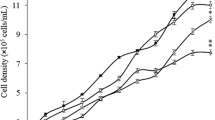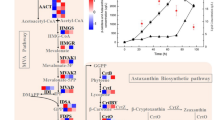Abstract
Dunaliella salina is a rich source of carotenoids. Carotenoid production is induced under specific conditions, i.e., high light intensity, high salt concentration, nutrient limitation, and suboptimal temperatures in this microalga. The control of environmental factors is vital for high productivity of carotenoids. In this paper, the effect of different ethanol concentrations in combination with nitrogen deficiency was investigated to induce carotenoid production in D. salina CCAP 19/18. Also, some biochemical and molecular parameters were investigated in response to ethanol in the cells. It was shown that ethanol at 0.5% concentration increased cell number but, at 5% concentration, reduced cell viability compared to the control. The highest carotenoid production was achieved at 3% ethanol concentration, which was 1.46 fold higher than the nitrogen deficiency condition. Investigation of the 3 carotenoid biosynthesis genes revealed that their expression levels increased at 3% ethanol concentration, and the phytoene synthase gene was the most upregulated one. Lipid peroxidation increased at both 3% and 5% ethanol concentrations. At 3% concentration, the activity of catalase and superoxide dismutase increased, but no significant changes were seen at 5% ethanol concentration. Peroxidase activity reduced at both 3% and 5% concentrations. Moreover, proline and reducing sugar content increased at 3% concentration while decreased at 5% ethanol concertation. The results showed that at 3% ethanol concentration, higher carotenoid productivity was associated with an increase in other intracellular responses (molecular and biochemical). Ethanol as a controllable element may be beneficial to increase carotenoid production even under inappropriate environmental conditions in D. salina.






Similar content being viewed by others
Data availability
All data generated or analysed during this study are included in this published article. If more data are needed it can be provided by corresponding author on reasonable request.
Code availability
Not applicable.
References
Aebi H (1984) Catalase in vitro. Meth Enzymol 105:121–126. https://doi.org/10.1016/S0076-6879(84)05016-3
Agravante JU, Matsui T, Kitagawa H (1990) Effect of ethanol on ripening and amylase activity of banana. Nippon Shokuhin Kogyo Gakkaishi 37(3):235–238. https://doi.org/10.3136/nskkk1962.37.3_235
Al-Rashed SA, Ibrahim MM, El-Gaaly GA, Al-Shehri S, Mostafa A (2016) Evaluation of radical scavenging system in two microalgae in response to interactive stresses of UV-B radiation and nitrogen starvation. Saudi J Biol Sci 23(6):706–712. https://doi.org/10.1016/j.sjbs.2016.06.010
Bailey SM, Pietsch EC, Cunningham CC (1999) Ethanol stimulates the production of reactive oxygen species at mitochondrial complexes I and III. Free Radic Biol Med 27:891–900. https://doi.org/10.1016/S0891-5849(99)00138-0
Barbarino E, Lourenço S (2005) An evaluation of methods for extraction and quantification of protein from marine macro and microalgae. J Appl Phycol 17:447–460. https://doi.org/10.1007/s10811-005-1641-4
Bates LS, Waldren RP, Teare ID (1973) Rapid determination of free proline for water stress studies. Plant Soil 39:205–207. https://doi.org/10.1007/BF00018060
Ben-Amotz A (1995) New mode of Dunaliella biotechology: two-phase growth for β-carotene production. J Appl Phycol 7:65–68. https://doi.org/10.1007/BF00003552
Ben-Amotz A, Katz A, Avron M (1982) Accumulation of β-carotene in halotolerant algae: Purification and characterization of β-carotene-rich globules from Dunaliella bardawil (Chlorophyceae). J Phycol 18:529–537. https://doi.org/10.1111/j.1529-8817.1982.tb03219.x
Borowitzka LJ (1992) Beta-Carotene production using algal biotechnology. J Nutr Sci Vitaminol 38:248–250. https://doi.org/10.3177/jnsv.38.Special_248
Borowitzka LJ, Borowitzka MA, Moulton T (1984) Mass culture of Dunaliella: from laboratory to pilot plant. Hydrobiologia 116:115–121. https://doi.org/10.1007/BF00046114
Capa-Robles W, García-Mendoza E, Paniagua-Michel JJ (2021) Enhanced β-carotene and biomass production by induced mixotrophy in Dunaliella salina across a combined strategy of glycerol, salinity, and light. Metabolites 11(12):866. https://doi.org/10.3390/metabo11120866
Coesel SN, Baumgartner AC, Teles LM, Ramos AA, Henriques NM, Cancela L, Varela JC (2008) Nutrient limitation is the main regulatory factor for carotenoid accumulation and for Psy and Pds steady state transcript levels in Dunaliella salina (Chlorophyta) exposed to high light and salt stress. Mar Biotechnol 10(5):602–611. https://doi.org/10.1007/s10126-008-9100-2
Couso I, Vila M, Vigara J, Vargas MA, Rodrı´guez H, Leo´n R (2012) Synthesis of carotenoids and regulation of the carotenoid biosynthesis pathway in response to high light stress in microalgae Chlamydomonas reinhardtii. Eur J Phycol 47:223–232. https://doi.org/10.1080/09670262.2012.692816
Cunningham FX, Pogson B, Sun Z, McDonald KA, DellaPenna D, Gantt E (1996) Functional analysis of the beta and epsilon lycopene cyclase enzymes of Arabidopsis reveals a mechanism for control of cyclic carotenoid formation. Plant Cell 8:1613–1626. https://doi.org/10.1105/tpc.8.9.1613
Das SK, Vasudevan DM (2005) Effect of ethanol on liver antioxidant defense systems: Adose dependent study. Indian J Clin Biochem 20(1):80–84. https://doi.org/10.1007/BF02893047
Dhindsa RS, Plumbdhindsa P, Thorpe TA (1981) Leaf senescence – correlated with increased levels of membrane permeability and lipid-peroxidation, and decreased levels of superoxide-dismutase and catalase. J Exp Bot 32:93–101. https://doi.org/10.1093/jxb/32.1.93
Garcia-Gonzalez M, Moreno J, Canavate JP, Anguis V, Prieto A, Manzano C, Folrencio FJ, Guerrero MG (2003) Condition for open-air outdoor of Dunaliella salina in southern Spain. J Appl Phycol 15:177–184. https://doi.org/10.1023/A:1023892520443
Gomez PI, Gonzalez MA (2005) The effect of temperature and irradiance on the growth and carotenogenic capacity of seven strains of Dunaliella salina (Chlorophyta) cultivated under laboratory conditions. Biol Res 38(2):151–162. https://doi.org/10.4067/S0716-97602005000200005
Guijarro JM, Lagunas R (1984) Saccharomyces cerevisiae does not accumulate ethanol against a concentration gradient. J Bacteriol 160:874–878. https://doi.org/10.1128/jb.160.3.874-878.1984
Haghjou MM, Shariati M, Smirnoff N (2009) The effect of acute high light and low temperature stresses on the ascorbate-glutathione cycle and superoxide dismutase activity in two Dunaliella salina strains. Physiol Plant 5(3):272–280. https://doi.org/10.1111/j.1399-3054.2008.01193.x
Heath RL, Packer L (1968) Photoperoxidation in isolated chloroplasts: I. Kinetics and stoichiometry of fatty acid peroxidation. Arch Biochem Biophys 125:189–198. https://doi.org/10.1016/0003-9861(68)90654-1
Hossain MA, Hoque MA, Burritt DJ, Fujita M (2014) Proline protects plants against abiotic oxidative stress: biochemical and molecular mechanisms. In: Ahmad P (ed) Oxidative damage to plants. San Diego, London, Waltham: Elsevier, pp. 477–522. https://doi.org/10.1016/B978-0-12-799963-0.00016-2
Hosseini Tafreshi A, Shariati M (2009) Dunaliella biotechnology: methods and applications. J Appl Microbiol 107(1):14–35. https://doi.org/10.1111/j.1365-2672.2009.04153.x
Ip PF, Wong KH, Chen F (2004) Enhanced production of astaxanthin by the green microalga Chlorella zofingiensis in mixotrophic culture. Process Biochem 39(11):1761–1766. https://doi.org/10.1016/j.procbio.2003.08.003
Johnson MK, Johnson EJ, MacElroy RD, Speer HL, Bruff BS (1968) Effects of salts on the halophilic algae Dunaliella viridis. J Bacteriol 95:1461–1468. https://doi.org/10.1128/jb.95.4.1461-1468.1968
Kakizono T, Kobayashi M, Nagai S (1992) Effect of carbon/nitrogen ratio on encystment accompanied with astaxanthin formation in a green alga Haematococcus pluvialis. J Ferment Bioeng 74(6):403–405. https://doi.org/10.1016/0922-338X(92)90041-R
Lamers PP, Janssen M, De Vos RCH, Bino RJ, Wijffels RH (2008) Exploring and exploiting carotenoid accumulation in Dunaliella salina for cell-factory applications. Trends Biotechnol 26(11):631–638. https://doi.org/10.1016/j.tibtech.2008.07.002
Li XQ, Li SH, Chen DF, Meng F (2004) Induced activity of superoxide dismutase and peroxidase of in vitro plants by low concentrations of ethanol. Plant Cell Tissue Organ Cult 79(1):83–86. https://doi.org/10.1023/B:TICU.0000049439.36866.4e
Lichtenthaler HK (1987) Chlorophylls and carotenoids: pigments of photosynthetic bio membranes. Meth Enzymol 148:350–386. https://doi.org/10.1016/0076-6879(87)48036-1
Matsudo MC, Bezerra RP, Sato S, Converti A, Carvalho JCM (2011) Use of CO2 from alcoholic fermentation for continuous cultivation of Arthrospira (Spirulina) platensis in tubular photobioreactor using urea as nitrogen source. Biotechnol Prog 27:650–656. https://doi.org/10.1002/btpr.581
Matsudo MC, Sousa TF, Pérez-Mora LS, Bezerra RP, Sato S, Carvalho JCM (2016) Ethanol as complementary carbon source in Scenedesmus obliquus cultivation. J Chem Technol Biotechnol 92:781–786. https://doi.org/10.1002/jctb.5059
Mehrabani LV (2019) The effects of methanol and ethanol foliar application under salinity stress on some physiological characteristics of Pelargonium graveolens L. J Plant Physiol Breed 9(1):63–73. https://doi.org/10.22034/JPPB.2019.10368
Miller GL (1959) Use of dinitrosalicylic acid reagent for determination of reducing sugar. Anal Chem 31:426–428. https://doi.org/10.1021/ac60147a030
Mojaat M, Pruvost J, Foucault A, Legrand J (2008) Effect of organic carbon sources and Fe2+ ions on growth and b-carotene accumulation by Dunaliella salina. Biochem Eng J 39:177–184. https://doi.org/10.1016/j.bej.2007.09.009
Mokrosnop VM, Polishchuk AV, Zolotareva EK (2016) Accumulation of α-tocopherol and β-carotene in Euglena gracilis cells under autotrophic and mixotrophic culture conditions. Appl Biochem Microbiol 52:216–221. https://doi.org/10.1134/S0003683816020101
Morowvat M, Ghasemi Y (2016) Culture medium optimization for enhanced β-carotene and biomass production by Dunaliella salina in mixotrophic culture. Biocatal Agric Biotechnol 7:217–223. https://doi.org/10.1016/j.bcab.2016.06.008
Pulz O, Gross W (2004) Valuable products from biotechnology of microalgae. Appl Microbiol Biotechnol 65:635–648. https://doi.org/10.1007/s00253-004-1647-x
Rabbani S, Beyer P, Lintig J, Hugueney P, Kleinig H (1998) Induced beta–carotene synthesis driven by triacylglycerol deposition in the unicellular alga Dunaliella bardawil. Plant Physiol 116:1239–1248. https://doi.org/10.1104/pp.116.4.1239
Raja R, Hemaiswarya S, Rengasamy R (2007) Exploitation of Dunaliella for beta-carotene production. Appl Microbiol Biotechnol 74(3):517–523. https://doi.org/10.1007/s00253-006-0777-8
Rezayian M, Niknam V, Ebrahimzadeh H (2019) Oxidative damage and antioxidative system in algae. Toxicol Rep 24(6):1309–1313. https://doi.org/10.1016/j.toxrep.2019.10.001
Sánchez-Estudillo L, Freile-Pelegrin Y, Rivera-Madrid R, Robledo D, Narváez-Zapata JA (2006) Regulation of two photosynthetic pigment-related genes during stress-induced pigment formation in the green alga. Dunaliella Salina Biotechnol Lett 28(11):787–791. https://doi.org/10.1007/s10529-006-9001-2
Soltani Nezhad F, Mansouri H (2017) Effects of polyploidy on response of Dunaliella salina to salinity. J Mar Biol Assoc UK 74:41–47. https://doi.org/10.1017/S0025315418001005
Tadros MG, Philips J, Patel H, Pandiripally V (1994) Differential Response of Green Algal Species to Solvents. Bull Environ Contam Toxicol 52:333–337. https://doi.org/10.1007/BF00197817
Takagi H, Taguchi J, Kaino T (2016) Proline accumulation protects Saccharomyces cerevisiae cells in stationary phase from ethanol stress by reducing reactive oxygen species levels. Yeast 33(8):355–363. https://doi.org/10.1002/yea.3154
Valdes C (2011) Can Brazil Meet the World’s Growing Need for Ethanol?. In: Economic Research Service. United States Department of Agriculture. Available via AMBER WAVES. http://www.ers.usda.gov/amber-waves/2011-december/can-brazil-meet-the-world%E2%80%99s-growing-need-for-ethanol.aspx#.UgK8JJKkpex
Valluru R, Van den Ende W (2008) Plant fructans in stress environments: emerging concepts and future prospects. J Exp Bot 59:2905–2916. https://doi.org/10.1093/jxb/ern164
Vidhyavathi R, Venkatachalam L, Sarada R, Ravishankar GA (2008) Regulation of carotenoid biosynthetic genes expression and carotenoid accumulation in the green alga Haematococcus pluvialis under nutrient stress conditions. J Exp Bot 59:1409–1418. https://doi.org/10.1093/jxb/ern048
Wen Z, Liu Z, Hou Y, Liu C, Gao F, Zheng Y, Chen F (2015) Ethanol induced astaxanthin accumulateon and transcriptional expression of carotenogenic genes in Haematococcus pluvialis. Enzyme Microb Technol 78:10–17. https://doi.org/10.1016/j.enzmictec.2015.06.010
Wu Z, Akter R, Arirob W, Juntawong N, Ma C, Deangmanee P (2015) Effects of light intensity and the remaining nitrate concentration on the beta-carotene accumulation of a wild Dunaliella salina strain isolated from the saline soil. Microbiol Res 6(1):1–5. https://doi.org/10.4081/mr.2015.6233
Ye Zw, Jiang JG, Wu GH (2008) Biosynthesis and regulation of carotenoids in Dunaliella: progresses and prospects. Biotechnol Adv 26(4):352-360. https://doi.org/10.1016/j.biotechadv.2008.03.004
Yilancioglu K, Cokol M, Pastirmaci I, Erman B, Cetiner S (2014) Oxidative stress is a mediator for increased lipid accumulation in a newly isolated Dunaliella salina strain. PLoS One 9(3):e91957. https://doi.org/10.1371/journal.pone.0091957
Yoval-Sánchez B, Jasso-Chávez R, Lira-Silva E, Moreno-Sánchez R, Rodríguez-Zavala JS (2011) Novel mitochondrial alcohol metabolizing enzymes of Euglena gracilis. J Bioenerg Biomembr 43:519–530. https://doi.org/10.1007/s10863-011-9373-4
Zaharieva T, Yamashita K, Matsumoto H (1999) Iron deficiency induced changes in ascorbate content and enzyme activities related to ascorbate metabolism in cucumber roots. Plant Cell Physiol 40:273–280. https://doi.org/10.1093/oxfordjournals.pcp.a029538
Funding
This study was financially supported by the Alzahra University, Tehran, Iran, and by Grant No. 970203 of the Biotechnology Development Council of the Islamic Republic of Iran.
Author information
Authors and Affiliations
Contributions
Data Acquisition was carried out by Aida Hamidkhani. Formal analysis and validation of data was done by Aida Hamidkhani, Azra Saboora, Nassim Gorbanmehr and Ezat Asgarani. Preparation of the manuscript draft was done by Aida Hamidkhani. Ezat Asgarani, Nassim Gorbanmehr and Azra Saboora provided administrative, technical and material support. Supervision of the work was done by Azra Saboora, Ezat Asgarani and Mohammad A. Hejazi.
Corresponding author
Ethics declarations
Ethics approval
Not applicable.
Consent to publish
All authors are willing to publish this work.
Conflicts of interest
The authors declare that they have no conflict of interest.
Additional information
Publisher's Note
Springer Nature remains neutral with regard to jurisdictional claims in published maps and institutional affiliations.
Supplementary Information
Below is the link to the electronic supplementary material.
Rights and permissions
Springer Nature or its licensor (e.g. a society or other partner) holds exclusive rights to this article under a publishing agreement with the author(s) or other rightsholder(s); author self-archiving of the accepted manuscript version of this article is solely governed by the terms of such publishing agreement and applicable law.
About this article
Cite this article
Hamidkhani, A., Asgarani, E., Saboora, A. et al. Ethanol as a carotenoid production stimulator in Dunaliella salina CCAP 19/18. Folia Microbiol 68, 925–937 (2023). https://doi.org/10.1007/s12223-023-01062-y
Received:
Accepted:
Published:
Issue Date:
DOI: https://doi.org/10.1007/s12223-023-01062-y




